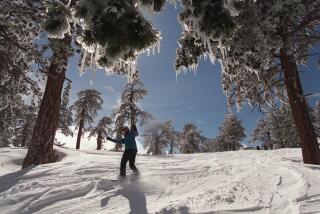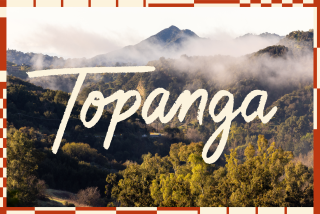Jemez, the Southwest’s little secret
Jemez Springs, N.M.
I first stumbled across the Jemez area about 18 years ago, after taking a spontaneous detour off the main route from Taos to Albuquerque. My goal was simply to hike toward some interesting Native American ruins near Los Alamos.
Hike completed, I thought it made sense to stay on rustic New Mexico 4, which would eventually loop me back toward the main freeway. But along the way, I came across spots so inviting and unvisited by New Agers or tourists searching out coyote sculpture and turquoise jewelry that I decided to stick around for a couple of days.
Driving south along Highway 4 is like viewing a slide show of the state’s wonders. First, a vast caldera, a meadow formed by the collapse of an unimaginably huge volcano, ringed by the remnants of the volcano’s edges, where elk commonly graze.
Then, pristine ponderosa pines, obsidian cliffs, waterfalls, a scenic river spilling through a natural mineral dam, until reaching the center of it all, the unvarnished little town of Jemez Springs, with a bathhouse that pulls its smelly, steaming waters from natural hot springs. Farther south, a sparsely populated valley framed by red rock formations gives way to a Native American pueblo.
The Jemez area wasn’t mentioned in my visitor guides. And although it has grown in popularity as a weekend destination from Albuquerque and Santa Fe, it’s still curiously unknown to the larger world, which makes it a good getaway for anyone seeking some summer solace. A visitor from California is likely to be asked — repeatedly — “How did you hear about us?”
Thousands of years and stories
The Jemez area’s history, as with that of much of New Mexico, dates back hundreds and probably thousands of years to the pueblos constructed of the local clay and cave dwellings carved out of the tuff hillsides.
On a recent trip, one of our favorite sightseeing activities was at Bandelier National Monument, toward the northeastern end of New Mexico 4. An easy hike led us to an ancient village, with a kiva and petroglyphs. Ladders along the trail allowed us to climb up and explore the caves ourselves.
After Spaniards tried to convert the native population by force, the people of the Jemez area took part in the great Pueblo Revolt of 1680, which succeeded in expelling the Spanish. Twelve years later, however, the area was retaken.
An ancient pueblo is now a state monument just north of the town of Jemez Springs; many of the descendants of those natives live in Jemez Pueblo toward the southern end of the Jemez Valley, in Walatowa Village.
The Jemez are a tradition-oriented tribe that has rejected the idea of opening a casino. In fact, the pueblo is not open to the public except for certain festival days.
But visitors can buy fry bread at a roadside stall and drive to individual houses — there are rudimentary signs pointing the way — to browse the Jemez pottery, made from clay that the artists collect from the nearby hills, process according to longtime traditions and bake in homemade kilns.
At the center of the valley is the town of Jemez Springs, which became famous in the 19th century for the mineral springs that bubble up around the village.
The town recently was the setting for “Jemez Spring,” a murder-mystery novel by Rudolfo Anaya. It was the fourth of Anaya’s season-themed Sonny Baca mysteries set in the larger Albuquerque area (and, although it’s not much of a page-turner as a mystery, it is worth reading for Anaya’s poetic ability to convey the culture, spirit and mystery of the place).
Indeed, the dastardly deed takes place at the bathhouse, which offers inexpensive soaks in huge, unpretentious concrete tubs as well as low-priced massages. Those who want a more natural experience should try Spence Springs, which is a few miles north of town. The natural hot springs are at the end of a short, steep hike.
There, set into the cliff’s side, two natural rock pools, one below the other, offer a choice between comfortably warm and downright hot. Spence is best visited on weekdays — it gets crowded on weekends — and by people who don’t mind a little casual public nudity.
For those who prefer a tamer outdoor experience that involves no hiking, privately owned Giggling Springs is down a short driveway in the heart of Jemez Springs and costs $15 for an hour’s soak.
Jemez is curiously uncrowded and tourist-free in the spring and fall, especially considering it’s little more than an hour’s drive north of Albuquerque International Sunport.
The area has long been a spot for fishing, hunting, hiking and archeological field trips. These activities are coupled with a soul-filling sense of peace and history, encountered in forests, arroyos, lakes and parks around the region. Recently, the area’s tourism industry has grown, from one wood-paneled diner to a handful of eateries (bring extra provisions, however; sometimes, all the nearby restaurants are closed at the same time), from one rundown little motel to a choice of inns, rental houses and B&Bs.
And where once there was only a tiny general store, now there are several small gift shops selling native crafts, a day spa and even a small, family-owned winery where the friendly owners pour out glasses of their vintages and share the local gossip.
Perhaps the biggest change in Jemez has been the creation of the Valles Caldera National Preserve, where gigantic volcanic eruptions more than a million years ago spewed ash for miles, creating the tuff cliffs from which Bandelier’s cave dwellings were carved and forming two great calderas. Although the larger caldera, Valle Grande, is situated right along New Mexico 4, much of the federally owned preserve is operated as a fenced-off recreational area where small groups of visitors can go (only by reservation) for such activities as fishing classes and hay-wagon rides in summer or cross-country skiing and sleigh rides in winter.
Casual quarters
My most recent visit included my husband and two children, so we looked online and found a house to rent along the Jemez River. We wanted a comfortable living space and the flexibility to prepare meals in. (Consetta’s, a charming restaurant next door, is open only at certain times of the year, and the only exceptionally good food we found in the area were the blueberry-corn pancakes at Deb’s Diner.) At $95 a night for the four of us, the house, called Ranchito Milagro, was a bargain. It’s owned by documentary filmmaker Kathleen Phelan, who moved here from Venice Beach.
It wasn’t exactly like renting a guest house; Phelan, it turns out, stays in another part of the home, separated by a folding room divider, and her two dogs frequently wandered in through the back dog door for friendly visits.
Jemez is still unspoiled enough that these kinds of setups are common. Residents run little tourism-related businesses but generally need other jobs to keep going. For instance, the owner of Consetta’s is a librarian at the Jemez Pueblo, and the owner of Giggling Springs doubles as a real-estate agent.
We were comfortable enough with the casual arrangement, as well as with the dogs. And Phelan, who is working to set up a tour-package business, proved a helpful guide.
We fished in the river out back (the house was without a river view, but it was a short enough walk there that we let the kids wander down by themselves) and hiked to waterfalls and hot springs. Soda Dam, just off New Mexico 4 north of the village, creates a little pool of fresh river water, great for swimming.
Phelan also helped us set up a 90-minute horseback ride that was supposed to take place at an offbeat, rustic spot. But the stable instead took its horses that day down to the ritzy Hyatt Regency Tamaya Resort & Spa at Santa Ana Pueblo, an hour’s drive. The horses were excellent, not the typical drab, plodding trail steeds, and unlike on most guided trail rides, we were allowed to let them trot and canter. But the terrain wasn’t particularly scenic, the sun was brutal, and though the kids enjoyed it, at $75 a head, it was an experience I could have skipped.
Night life in the Jemez area is limited. Locals head to Los Ojos, an old and still-authentic Western-style saloon and diner, for a beer and conversation. For those inclined to quieter pursuits, the Milky Way puts on a spectacular show in the clear night sky.
karin.klein@latimes.com
More to Read
Sign up for The Wild
We’ll help you find the best places to hike, bike and run, as well as the perfect silent spots for meditation and yoga.
You may occasionally receive promotional content from the Los Angeles Times.







